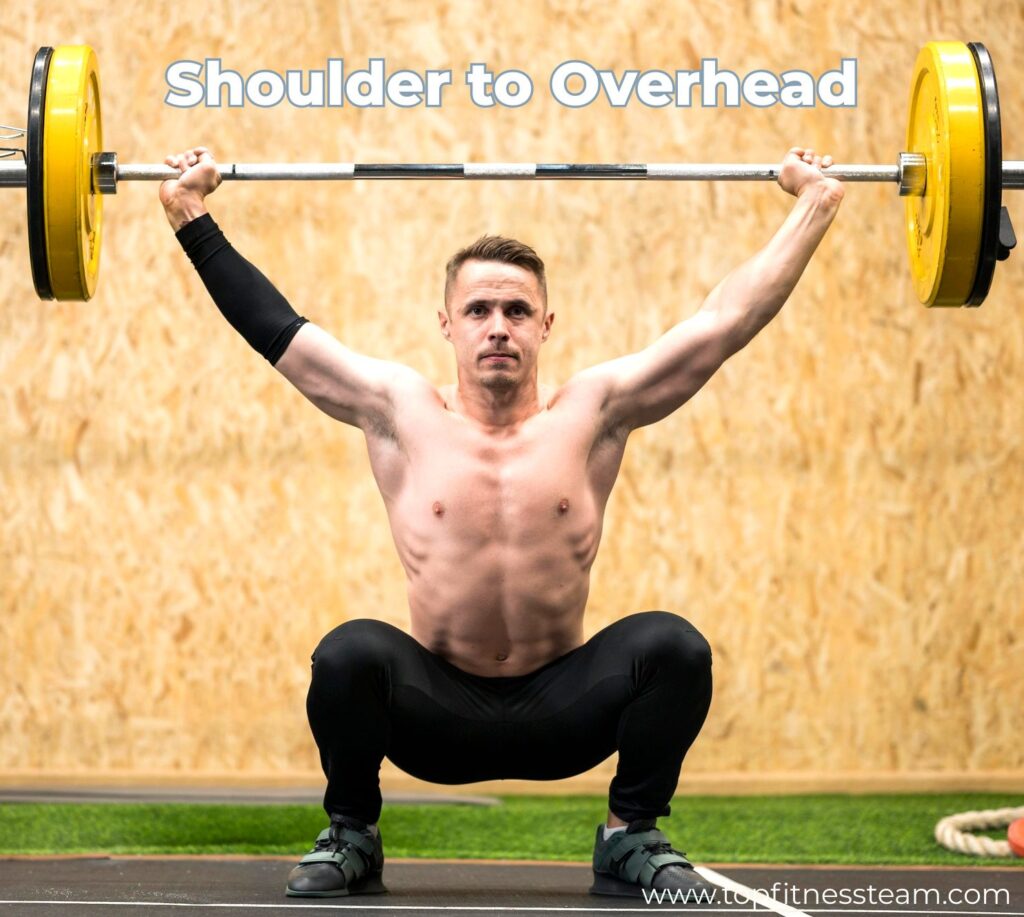Hello everyone, Top Fitness Team is here. This article will tell you about Shoulder to Overhead.
Introduction
Weightlifting is not merely about lifting heavy weights. It is about understanding body technicians and optimizing movements for efficiency.
This article delves into specific weightlifting techniques and their impact on our body, from our hips and knees to the complex workings of our shoulder joints.
Shoulder to overhead CrossFit
CrossFit’s shoulder-to-overhead movement displays power and technique. Beginning with the weight at the front rack position on the shoulders, athletes must expertly press, push, or jerk it overhead, extending their arms fully.
This multifaceted exercise employs the upper body, especially the deltoids and triceps. It demands core stabilization, making it a staple in CrossFit regimens worldwide.
Hips and Knees: The Power Generators
The hips and knees are pivotal in almost every weightlifting movement. As the body’s powerhouse, these joints transfer energy from the ground upwards.
A correctly performed deadlift or squat emanates power from these joints. Yet, incorrect poses can derail our performance.
To understand this more, the article Barbell Cycling Strategies: Shoulder to Overhead gives detailed insights.
Extend Your Arms: The Importance of Full Extension
Extending your arms is about reaching out and fully utilizing the kinetic chain, channeling energy seamlessly.
The complete attachment provides that the force travels from the lower body through the spine and out through the arms, vital for moves like the snatch or clean and jerk.
Shoulder Blades: The Unsung Heroes of Stabilization
Your shoulder blades, or scapulae, play a key role in weightlifting. Acting as stabilizers, they provide that your upper body moves with precision.
Without the scapular stability, techniques can falter, making moves like the overhead press more challenging. See the Top 10 Best Band Shoulder Exercises for more exercises targeting these muscles.
Split Jerk vs. Push Jerk: A Close Analysis
While the split jerk and push jerk techniques aim to get the weight overhead, they are executed differently. The split jerk involves a lunge-like motion, whereas the push jerk uses a more specific dip and drive.
Knowing when and how to use each can be a game-changer in weightlifting regimes.
Getting the Weight Overhead: The Techniques
Lifting weight overhead can be achieved through various techniques. Strict pressing is about raw strength without momentum, while push press combines a slight dip to assist the press.
And then there’s the overhead squat, a test of balance and flexibility. The Top 10 Dumbbell Shoulder Exercises 2023 offers excellent insights for more variations.
Shoulder Joint: The Hub of Upper Body Movements
With its wide range of motion, the shoulder joint is central to many weightlifting moves. Yet, it is also prone to injuries if not engaged correctly.
Proper engagement ensures the joint is protected while maximizing the lift, essential for movements like the push press or strict pressing.
Push Press vs. Strict Pressing: A Deeper Dive
The push press combines leg drive and upper body strength, which differs from strict pressing, which relies solely on upper body strength.
Knowing when to use each technique can be instrumental in progress and injury prevention, depending on the workout goal.
You should explore the Top 10 Best Cable Chest Workouts for chest-specific exercises.
Summary
From the foundation set by our hips and knees to the intricacies of our shoulder joints, weightlifting is a dance of techniques and understanding.
Incorporating the correct method boosts performance and provides longevity in the sport. And for those aiming to optimize their glute workouts, the Best 20 Glute Machines For Your Workouts can be a helpful resource.
My Final Thoughts
Weightlifting transforms from mere lifting to an art form when understood in depth. Prioritize learning and continually refine techniques.
The body’s interconnectedness is profound, and mastering this can lead to unparalleled weightlifting success. Remember, it is not just about lifting. It is about swiping right.
FAQs
Q: What does shoulder to overhead mean in Crossfit?
Ans: Shoulder to overhead in Crossfit refers to any movement that starts with the weight at the front rack position (on your ) and ends with the weight fully extended overhead.
Q: What is the difference between push press and shoulder to overhead?
Ans: While push press is a specific technique that uses a dip and drive motion to press the weight overhead, shoulder to overhead is a general term that can include various methods like push press, strict press, and jerk.
Q: Is shoulder-to-overhead strict?
Ans: No, shoulder-to-overhead is not inherently strict. It can be executed using various methods, including strict press, push press, or jerk. Rigid refers to lifting without using momentum or additional body movement.
Q: What is a dumbbell shoulder to overhead?
Ans: A dumbbell shoulder to overhead is a movement where an individual presses a dumbbell from the shoulder level to a fully extended position overhead. It can be done using strict, push, or jerk techniques.
Q: What does shoulder-to-overhead work?
Ans: The shoulder to overhead primarily targets the deltoids, triceps, and upper pectoral muscles. Depending on the technique, it can also engage the core, legs, and other stabilizing muscles.
Thanks
